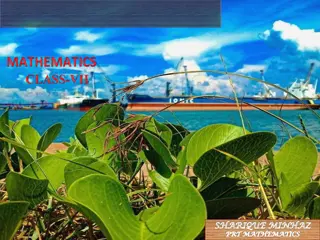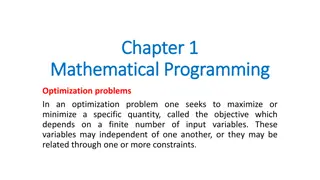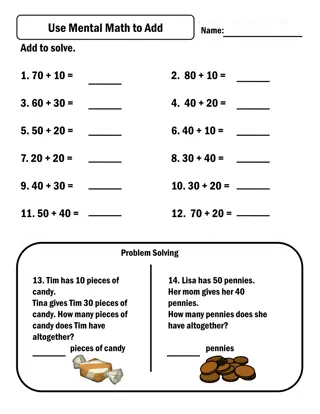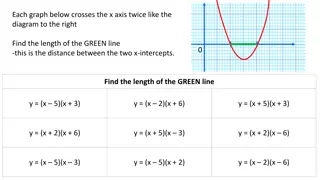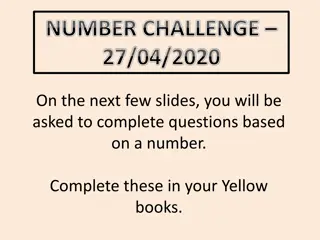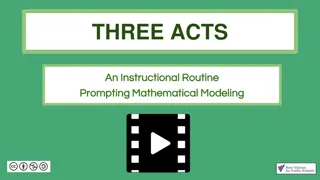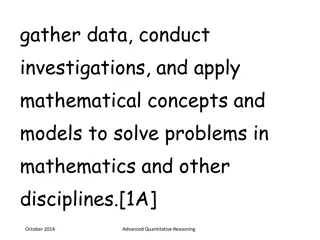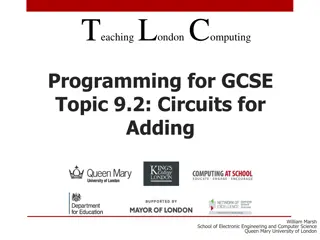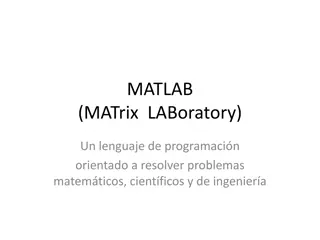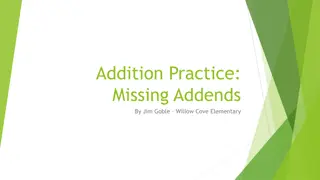Effective Addition Strategies for Mathematical Problems
Explore various addition strategies such as adding up in chunks, using place value, compensation, making a ten/bridging through ten, and leveraging near doubles. These methods provide a practical approach to solving addition problems efficiently and accurately by breaking down numbers and manipulating them strategically. Enhance your basic math skills with these useful techniques.
Download Presentation

Please find below an Image/Link to download the presentation.
The content on the website is provided AS IS for your information and personal use only. It may not be sold, licensed, or shared on other websites without obtaining consent from the author.If you encounter any issues during the download, it is possible that the publisher has removed the file from their server.
You are allowed to download the files provided on this website for personal or commercial use, subject to the condition that they are used lawfully. All files are the property of their respective owners.
The content on the website is provided AS IS for your information and personal use only. It may not be sold, licensed, or shared on other websites without obtaining consent from the author.
E N D
Presentation Transcript
Addition Strategy Add Up In Chunks Keep the first number whole, add the second number in friendly chunks 23 + 12 +10 +2 23 33 35
Addition Strategy Add Up In Chunks Keep the first number whole, add the second number in friendly chunks 209 + 124 +100 +20 +1 +3 329330 209 309 333
Addition Strategy Place Value Partition the numbers and add by the place value 21 + 14 20 1 10 4 20 + 10 = 30 1 + 4 = 5 30 + 5 = 35
Addition Strategy Place Value Partition the numbers and add by the place value 124 + 235 100 + 200 = 300 20 + 30 = 50 4 + 5 = 9 300 + 50 + 9 = 359
Addition Strategy Compensation Make friendly numbers by removing from one number and adding the same amount to the other number 17 + 19 -1 +1 16 + 20 = 36
Addition Strategy Compensation Make friendly numbers by removing from one number and adding the same amount to the other number 135 + 118 -2 +2 133 + 120 = 253
Addition Strategy Making a Ten/Bridging Through Ten Make a ten by partitioning a number 18 + 6 2 4 10 + (8 + 2) = 20 20 + 4 = 24
Addition Strategy Making a Ten/Bridging Through Ten Make a ten by partitioning a number 137 + 118 3 5 130 + 110 + (7 + 3) + 5 240 + (7 + 3) + 5 250 + 5 = 255
Addition Strategy Near Doubles Knowing Doubles helps with Near Doubles 25 + 26 25 + 26 = 25 + (25 + 1) 1 25 25 50 + 1 = 51
Addition Strategy Near Doubles Knowing Doubles helps with Near Doubles 340 + 330 340 + 330 = 340 + (340 - 10) 680 10 = 670
Subtraction Strategy Removal Partition to remove the number within the subtraction. 22 8 = 14 -6 -2 20 22 14
Subtraction Strategy Removal Partition to remove the number within the subtraction. 132 47 = 14 -32 -15 132 85 100
Subtraction Strategy Add Up Partition to add from the lowest number to the highest number 50 39 1 + 10 = 11 +1 +10 50 3940
Subtraction Strategy Add Up Partition to add from the lowest number to the highest number 123 68 +2 +30 2 + 30 + 23 = 55 +23 6870 100 123
Subtraction Strategy Place Value Subtraction and Negative Numbers Partition and subtract using place value 75 38 70 30 = 40 5 8 = -3 40 3 = 37
Subtraction Strategy Place Value Subtraction and Negative Numbers Partition and subtract using place value 243 169 200 100 = 100 40 60 = -20 3 9 = -6 100 20 6 = 74
Subtraction Strategy Keeping a Constant Difference Adjust both numbers in the same way to create a friendly number to keep the difference constant. 53 29 = 54 30 = 24 5354 2930
Subtraction Strategy Adjust One Number to Create an Easier Problem Adjust one number to make a friendly number 43 29 +1 43 30 = 13 13 + 1 = 14
Multiplication Strategy Repeated Addition Repeat the addition of one factor by the number of times the other factor 4 x 9 +9 +9 +9 +9 0 18 27 9 36
Multiplication Strategy Making Friendly Numbers Partition to use a friendly number to solve a more challenging problem 3 x 37 - (3 x 3) (3 x 40) 3 x 40 = 120 3 x 3 = 9 120 - 9 = 111
Multiplication Strategy Partial Products Partition one factor using place value and use distributive property to multiply 6 x 325 6 x (300 + 20 + 5) 300 6 20 5 6 30 1800 120 1800 + 120 + 30 = 1950
Multiplication Strategy Breaking Factors into Smaller Factors Break a factor into smaller factors and apply the associative property 8 x 25 6 So 2 x 4 x 25 = 2 x 100 = 200
Multiplication Strategy Doubling and Halving Double one factor and halve the other to simplify a problem 4 x 125 = 2 x 250 = 1 x 500 = 500 4 6 125 2 250 1 500
Division Strategy Repeated Subtraction Repeat the subtraction of the divisor until the difference is less than the divisor 12 4 -4 -4 -4 3 0 8 12 4
Division Strategy Repeated Subtraction Repeat the subtraction of the divisor until the difference is less than the divisor 129 40 -40 -40 -40 3 R9 9 89 129 49
Division Strategy Partial Quotients Partition the dividend into parts easily divisible by the divisor 56 4 4 + (16 4) 56 6 Think (40 4) 4 40 10 16 4 14 + =
Division Strategy Partial Quotients Partition the dividend into parts easily divisible by the divisor 58 4 4 + (16 4) + 2 58 6 Think (40 4) 4 40 10 16 4 2 + = 14 R2
Division Strategy Multiplying Up Use the multiples of the divisor to find the total dividend 65 5 5 x 10 = 50 5 x 3 = 15 5 x 13 = 65 6 65 5 = 13
Division Strategy Proportional Reasoning Divide the dividend and the divisor by the same amount to simplify the problem 192 8 2 2 ??? ? =?? ?=?? = 96 4 2 = 48 2 2 = 24 1 = 24 ?= ?? 6 2 2



